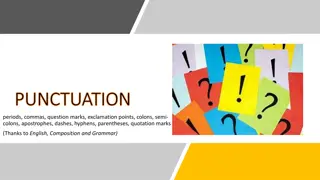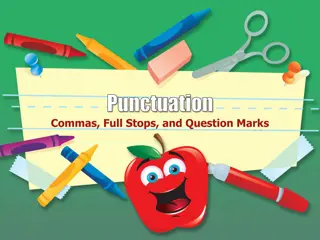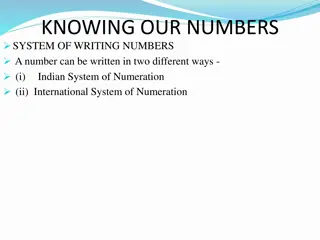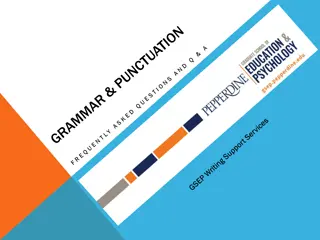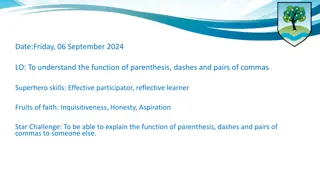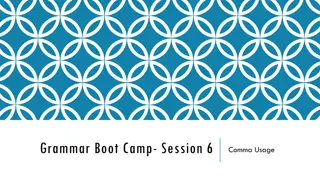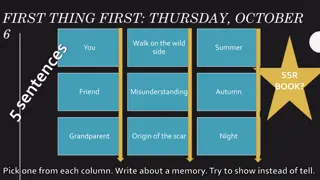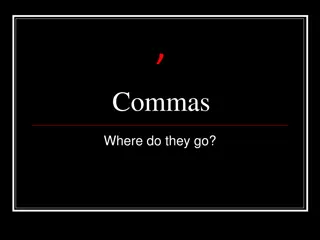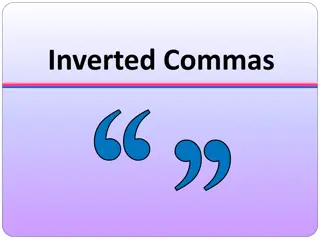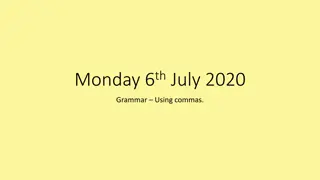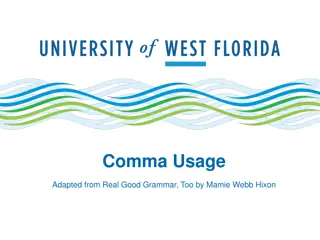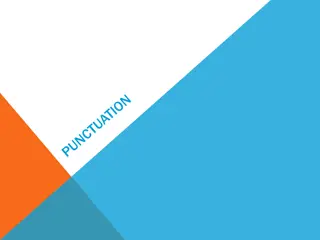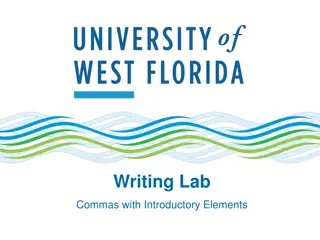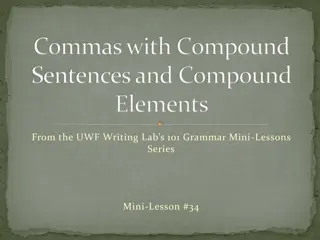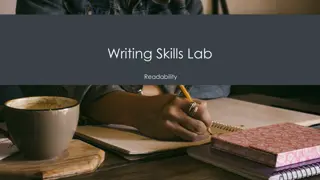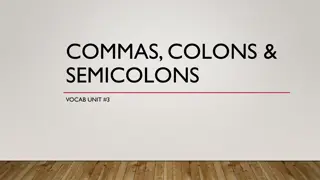Mastering Commas: A Comprehensive Guide for Writing Clarity
Explore the fundamentals of comma usage in academic writing through detailed explanations and examples provided by the Vancouver Island University Writing Centre. Discover the essential rules to enhance your writing skills and avoid common pitfalls associated with incorrect comma placement. Gain valuable insights into the significance of commas in structuring sentences effectively.
Download Presentation

Please find below an Image/Link to download the presentation.
The content on the website is provided AS IS for your information and personal use only. It may not be sold, licensed, or shared on other websites without obtaining consent from the author. Download presentation by click this link. If you encounter any issues during the download, it is possible that the publisher has removed the file from their server.
E N D
Presentation Transcript
1-2-3: Comma Basics An International Academic Support/ Writing Centre Workshop Vancouver Island University By Sylvia Arnold January 14, 2021 Vancouver Island University With references to https://services.viu.ca/sites/default/files/how_to_use_commas.pdf
First off, why commas? Used correctly, commas are useful guides to how to read a sentence; used wrongly, they can trip a reader up. -- John Hill, VIU Writing Centre Coordinator
Q. Which punctuation mark is easier to explain? 1. The Comma? Or 2. The semicolon?
A: Hands down its The semicolon Rule #1(~95% of the time) X The comma 9+ rules, all fairly common + Rule #2 (you got it ~5% of the time)
Nine rules!! Today, I will focus on three, the basics. 1. Use a comma between independent clauses followed by a coordinating conjunction (FANBOYS for, and, nor, but, or, yet, so). This rule will take a number of slides to explain. Bear with me! 2. Use a comma after words that come before the independent clause. 3. Use a comma to separate three or more items in a series.
To understand commas, lets first look at semicolon rule #1 (the ~ 95%-of-the-time rule). # 1. Use a semicolon between two independent clauses: Jim studied hard for his exam; he passed it. What s an independent clause you ask? Subject + Verb + complete idea. IMPORTANT: Every* sentence MUST have at least one independent clause. *Unless you re writing an ad, a text message, a novel, a poem, or in any situation in which you can say rules, what rules? or bah, rules
Q: Why do you think I chose green as the colour for an independent clause?
A: Green means Go or Yes! Green means yes, this IS an independent clause. The clause says, I can stand alone. I am independent. Jim studied hard for his exam. He passed it.
A key point to remember is this A semicolon and a period (aka a full stop) are close cousins,both strong. Jim studied hard for his exam; he passed it. Jim studied hard for his exam. He passed it. A comma is a very distant cousin and is weak. X Jim studied hard for his exam, he passed it. = comma splice (yikes!!!) And if you have no punctuation at all between the two, you have a run-on sentence, (yikes!!!): X Jim studied hard for his exam he passed it.
To put it another way, before we get to the first rule of commas, there is a do-NOT rule: Do NOT* use a comma to join two independent clauses. X Jim studied hard for his exam, he passed it. = a comma splice (yikes!!!) *Unless, again, you re writing an ad, a text message, a poem
BUT you CAN join two independent clauses with a comma IF IF you ALSO ALSO add a FANBOYS* word: a comma + a FANBOYS word Jim studied hard for his exam,so he passed it. ,for ,and ,nor ,but ,or ,yet ,so *FANBOYS, aka coordinating conjunctions (when used between two independent clauses) BOTH a comma AND a FANBOYS word are needed!
Thus, (finally!) comma rule #1 is Use a comma between independent clauses followed by a coordinating conjunction (FANBOYS for, and, nor, but, or, yet, so). Jim studied hard for his exam,so he passed it. Jim didn t study hard for his exam,but he passed it. (Plus, do NOT join independent clauses with only a comma!)
Lets practice comma rule #1: Which is/are correct? 1. Aya likes fitness classes she bought a rec centre membership. 2. Aya likes fitness classes, so she bought a rec centre membership. 3. Aya likes fitness classes, she bought a rec centre membership. 4. Aya likes fitness classes; she bought a rec centre membership. Answer: 2 & 4
More practice with rule #1: A. What about these two? 1. Aya likes fitness classes and bought a rec centre membership. 2. Aya likes fitness classes, and bought a rec centre membership. 3. Aya likes fitness classes, and she bought a rec centre membership. B. And these two? 1. Using commas effectively will help you stand out from the crowd for most people do not use them properly. 2. Using commas effectively will help you stand out from the crowd, for most people do not use them properly. Answers: A1, B2
Comma Rule #2: Use a comma after words that come before the independent clause. Stranded in the desert, Jim stared into the shimmering haze. Q: Why do you think I chose pink as a colour for the words before the independent clause?
A: Pink is the closest highlighting colour to red, meaning NO! Pink means this is NOT an independent clause. Because Jim was stranded in the desert,(dependent clause) Stranded in the desert, phrase In the desert, phrase (prepositional) Wearily, (word) The words say I CANNOT stand alone
I must be joined with an independent clause. Because Jim was stranded in the desert, he stared into the shimmering haze. Stranded in the desert, Jim stared into the shimmering haze. In the desert, Jim stared into the shimmering haze. Wearily, Jim stared into the shimmering haze. ( Please, please don t leave me alone. If you do, I m a sentence fragment. Yikes!!!! )
Lets practice comma rule #2: Which is/are correct? 1. Because Aya liked fitness classes she bought rec centre membership. 2. Because Aya liked fitness classes, she bought a rec centre membership. 3. Liking fitness classes Aya bought a rec centre membership. 4. An enthusiast of fitness classes, Aya bought a rec centre membership. Answer: 2 & 4
More practice with rule #2: How about these two? 1. Because Aya liked fitness classes, she bought a gym membership. 2. Aya bought a gym membership, because she liked fitness classes. Answer: 1
Fun Fact about dependent clauses: If they come before the independent clause, they are followed by a comma: (You knew that because it s comma rule #2 ) Because Aya liked swimming ,she bought a gym membership. BUT if they come after the independent clause, there is NO comma: Aya bought a gym membership because she liked swimming.
Comma rule # 3:Use a comma to separate three or more items in a series. He brought the beer, the Cheezies, and the dips. BUT do not use a comma if it s only two items in a series. She brought the wine and the chips. [Note optional final comma before and, known as the Oxford comma: it reduces ambiguity and is generally preferred in academic writing.]
Comma rule #3 contd: The items in the series can be a list of words: He brought the beer, the Cheezies, and the dips. a list of phrases: He wished for a change in the weather, a change in his social life, and a change in his grades at school. a list of clauses (not as common) He went to the party because he wanted to dance, he hoped to eat Cheezies, and he hoped to find a love interest.
Lets practice comma rule #3 Which is/are correct? 1. They are interested in sex, drugs, rock. 2. They are interested in sex, drugs, and rock. 3. They are interested in sex, drugs and rock. Answer: 2 & 3 (but 2 preferred)
More practice with comma rule #3 How about these? 1. They are interested in sex, drugs, rock and roll. 2. They are interested in sex, drugs, and rock and roll. 3. They are interested in sex, drugs, rock, and roll. 4. They are interested in sex, drugs and rock and roll. Answer: 2 & 4, but 2 preferred
Even more practice with rule #3 And these two? 1. In order to be better writers, students should learn the basics of sentence structure and punctuation, the main essay formats, and the methods of effective revision. 2. In order to be better writers, students should learn the basics of sentence structure and punctuation, the main essay formats, the methods of effective revision. Answer: 1
1-2-3 Practice This passage has no commas. Add them where needed. Sylvia gave a presentation about the basics of comma use and she gave some practice exercises. Before talking about commas she talked about semicolons. The presentation is just the beginning. In order to really learn how to use commas students need to know which rule(s) they have trouble with to pay close attention to their use of that rule and to get feedback and encouragement on their progress.
1-2-3 Answers Sylvia gave a presentation about the basics of comma use, and she gave some practice exercises. Before talking about commas, she talked about semicolons. The presentation is just the beginning. In order to really learn how to use commas, students need to know which rule(s) they have trouble with, pay close attention to their use of that rule, and get feedback and encouragement on their progress.
To recap, the basics of comma use are 1. Use a comma between independent clauses followed by a coordinating conjunction (FANBOYS for, and, nor, but, or, yet, so). 2. Use a comma after words that come before the independent clause. 3. Use a comma to separate three or more items in a series.
Next steps: Check out the Writing Centre s comprehensive NINE-rule handout on commas: https://services.viu.ca/sites/default/files/how_to_use_commas.pdf Get feedback (and encouragement!) on improving your comma use from a Writing Centre or International Academic Support faculty tutor: https://vancouver.mywconline.com/ Questions or suggestions? sylvia.arnold@viu.ca Good Luck! (Actually, it s not luck. It s attention, perseverance, and yet more attention )


